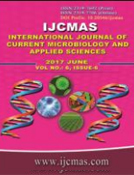


 National Academy of Agricultural Sciences (NAAS)
National Academy of Agricultural Sciences (NAAS)

|
PRINT ISSN : 2319-7692
Online ISSN : 2319-7706 Issues : 12 per year Publisher : Excellent Publishers Email : editorijcmas@gmail.com / submit@ijcmas.com Editor-in-chief: Dr.M.Prakash Index Copernicus ICV 2018: 95.39 NAAS RATING 2020: 5.38 |
Potential of antagonistic rhizobacteria Pseudomonas fluorescens in the management of bacterial wilt of different solanaceous crop, viz., tomato, brinjal and chilli caused by Ralstonia solanacearum was evaluated under in vitro and in vivo conditions. A total of twenty five (25) P. fluorescens isolates were collected from different rhizospheric soils of Assam and their characterization was done. Five (5) isolates produced fluorescents yellow green or bluish green diffusible pigment of variable intensities on King’s B medium under UV light (365 nm). These five isolates were identified to be classified under Biovar I (Pf-A1, Pf - A4, Pf - A7), Biovar II (Pf-A6) and Biovar III (PfA8) respectively, according to their biochemical differentiations. Dual culture tests using paper disc assay revealed that the strains Pf-A8 could cause highest inhibition in growth of R. solanacearum (tomato) by 76.0 per cent, 63.0 per cent (Brinjal) and 72.2 per cent (Chilli), respectively. Application of Pf-A8 based bio formulation as seed treatment, root treatment and soil application exhibited lowest wilt incidence (1.0%) in tomato plants, 2.0 per cent in brinjal plants and 4.0 per cent in chilli plants, respectively. The population dynamics of the pathogen and antagonist in crop rhizosphere soils showed significantly increase in all treatments as compared to controls. Corresponding to the enhancement of P. fluorescens population in the treated rhizosphere soil there was decline of R. solanacearum population. The correlation studies established a negative correlation between PWI and population density of P. fluorescens as well as between population densities of R. solanacearum and P. fluorescens. The finding furthers supports the biocontrol properties of the antagonistic strain P. fluorescens. The isolate Pf-A8 strains could serve as promising bioagent although needs further in situ investigations.
 |
 |
 |
 |
 |